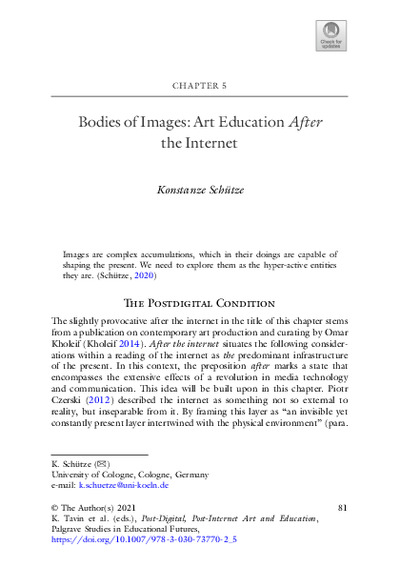Bodies of ImagesArt Education After the Internet
Konstanze Schütze
|
 |
 Diese Seite wurde seit 3 Jahren inhaltlich nicht mehr aktualisiert.
Unter Umständen ist sie nicht mehr aktuell.
Diese Seite wurde seit 3 Jahren inhaltlich nicht mehr aktualisiert.
Unter Umständen ist sie nicht mehr aktuell.
 Zusammenfassungen
Zusammenfassungen
 In this chapter, I present a series of thought experiments for a differentiated
exploration of what one might casually call the image. Basing on
three major theoretical concepts (meme theory, object-oriented ontology,
and network effects), images will be reintroduced as entities embedded
in complex structural realities that are both driving and driven forces of
culture. In this endeavor, they will be rendered as bodies compiled from
versions of themselves (bodies of images), explored embedded in dissemination
processes (memeplexes), and hence contoured as highly effective
structures with sophisticated potential for transformation (image objects).
With this re-interrogation of the image is the suggestion of reading of
images as entities that actively, or inactively, form structural assemblages
and maintain energetic human and non-human constellations. At the close of the exploration, a professional habitus is sketched in which art
educators are experts for image relations .
In this chapter, I present a series of thought experiments for a differentiated
exploration of what one might casually call the image. Basing on
three major theoretical concepts (meme theory, object-oriented ontology,
and network effects), images will be reintroduced as entities embedded
in complex structural realities that are both driving and driven forces of
culture. In this endeavor, they will be rendered as bodies compiled from
versions of themselves (bodies of images), explored embedded in dissemination
processes (memeplexes), and hence contoured as highly effective
structures with sophisticated potential for transformation (image objects).
With this re-interrogation of the image is the suggestion of reading of
images as entities that actively, or inactively, form structural assemblages
and maintain energetic human and non-human constellations. At the close of the exploration, a professional habitus is sketched in which art
educators are experts for image relations . This chapter explores a series of thought experiments for an investigation of what one casually calls the image. In this endeavor, images will be rendered as bodies compiled from versions of themselves (bodies of images), explored embedded in dissemination processes (memeplexes), and hence contoured as highly effective structures with sophisticated potential for transformation (image objects). Basing on three major theoretical concepts (meme theory, object-oriented ontology, and network effects), this re-interrogation of the image is the suggestion of a reading of images as entities that actively, or inactively, form structural assemblages and maintain energetic human and non-human constellations which shape the present. At the close of the exploration, a professional habitus is sketched in which art educators are experts for image relations.
This chapter explores a series of thought experiments for an investigation of what one casually calls the image. In this endeavor, images will be rendered as bodies compiled from versions of themselves (bodies of images), explored embedded in dissemination processes (memeplexes), and hence contoured as highly effective structures with sophisticated potential for transformation (image objects). Basing on three major theoretical concepts (meme theory, object-oriented ontology, and network effects), this re-interrogation of the image is the suggestion of a reading of images as entities that actively, or inactively, form structural assemblages and maintain energetic human and non-human constellations which shape the present. At the close of the exploration, a professional habitus is sketched in which art educators are experts for image relations. Dieses Kapitel erwähnt ...
Dieses Kapitel erwähnt ...
 Personen KB IB clear | Dirk Baecker , Susan Blackmore , Richard Dawkins , Markus Gabriel , Benjamin Jörissen , Bruno Latour , Torsten Meyer , Michael Seemann , Felix Stalder | |||||||||||||||||||||||||||||||||||||||||||||||||||||||||||||||||||||||||||||||||
 Begriffe KB IB clear |  Bilder
, Bildungeducation (Bildung)
, Digitalität
, Bilder
, Bildungeducation (Bildung)
, Digitalität
,  Internet Internet internet
, Netzwerkeffekte
, Theorietheory internet
, Netzwerkeffekte
, Theorietheory
| |||||||||||||||||||||||||||||||||||||||||||||||||||||||||||||||||||||||||||||||||
 Bücher |
|
 Dieses Kapitel erwähnt vermutlich nicht ...
Dieses Kapitel erwähnt vermutlich nicht ... 
 Nicht erwähnte Begriffe | Digitalisierung, Metcalfe's law, Schule |
 Zitationsgraph
Zitationsgraph
 Zitationsgraph (Beta-Test mit vis.js)
Zitationsgraph (Beta-Test mit vis.js)
 Anderswo finden
Anderswo finden
 Volltext dieses Dokuments
Volltext dieses Dokuments
 |  Bodies of Images: Art Education After the Internet: Artikel als Volltext bei Springerlink ( Bodies of Images: Art Education After the Internet: Artikel als Volltext bei Springerlink ( : :  , 238 kByte; , 238 kByte;  : :  ) ) |
 Anderswo suchen
Anderswo suchen 
 Beat und dieses Kapitel
Beat und dieses Kapitel
Beat hat Dieses Kapitel während seiner Zeit am Institut für Medien und Schule (IMS) ins Biblionetz aufgenommen. Beat besitzt kein physisches, aber ein digitales Exemplar. Eine digitale Version ist auf dem Internet verfügbar (s.o.). Es gibt bisher nur wenige Objekte im Biblionetz, die dieses Werk zitieren.

















 Biblionetz-History
Biblionetz-History